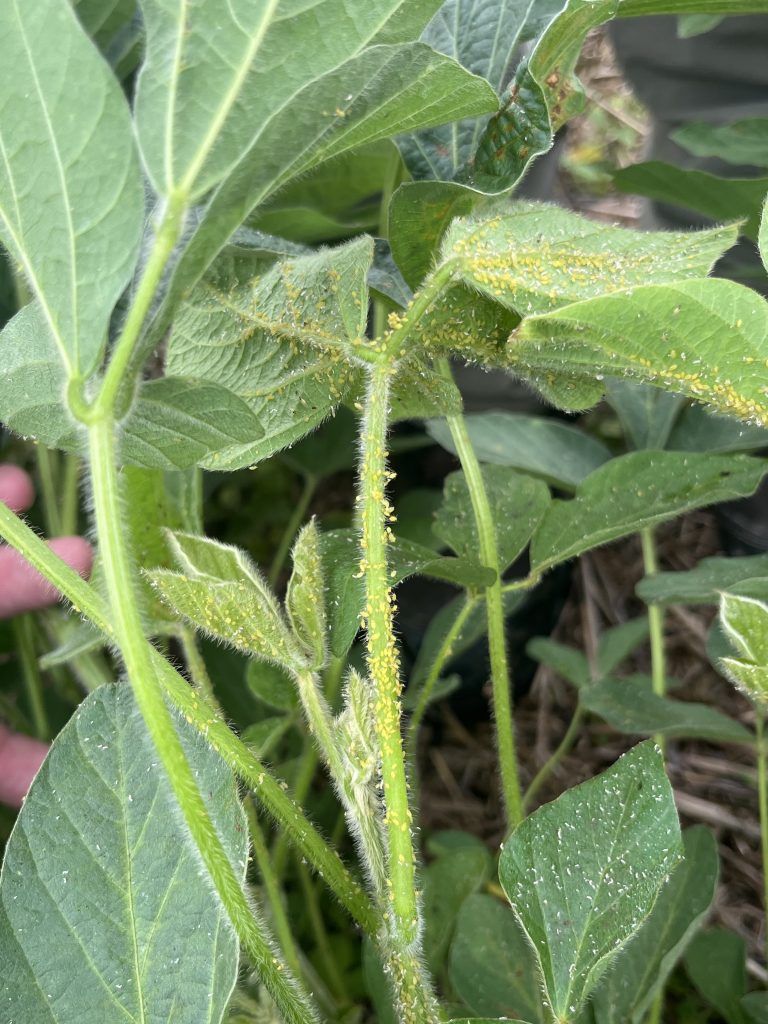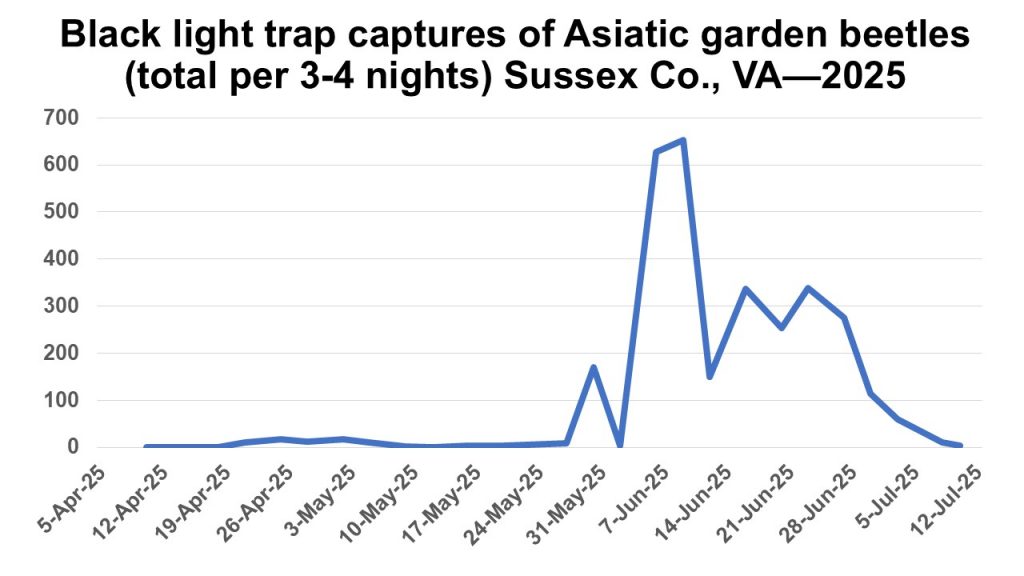Pheromone trap data from our cooperators across Virginia are in this Table. Virginia Cooperative Extension Agents Hélène Doughty (Northampton County) and Scott Reiter (Prince George County) reported many corn earworm larvae in soybean fields this week. Scott’s black light trap averaged 9.3 moths per night. With his help, our entomology program put in an insecticide efficacy experiment in Prince George soybean on August 20. The economic threshold calculator for corn earworm larvae in soybean can be found here. Our cypermethrin adult vial tests show 46% dead or down moths after 24 hours exposure time to this pyrethroid insecticide (n = 594 moths tested this season).
Category Archives: Insect
Corn earworm/bollworm update–August 14, 2025
Updated corn earworm moth catches from our pheromone trap network are in this Table. Prince George County’s black light had 11 total moths over the past 8 nights, but high numbers were caught in that county’s pheromone trap (averaging 42.5 per night over the past 8 nights).
Today in a project supported by USDA-NIFA Crop Protection and Pest Management’s Extension Implementation Program, our entomology crew sampled cotton in Suffolk, VA with no genetic protection against bollworm and found 14% boll injury due to this pest in the insecticide-untreated plot. There was no boll injury due to bollworm in the insecticide-untreated WideStrike or Bollgard 3 plots.
Soybean Aphids Found in Mid-Season Soybeans
Robbie Longest, Essex County Extension Agent
Carrie Ortel, Extension Soybean Agronomist
Tim Bryant, Extension Entomologist

Recently, soybean aphids have been confirmed at higher populations than typically expected in August. While many folks are scouting for worms and stinkbugs, we also recommend looking for aphids in your soybean fields as well. The key variables to consider regarding managing soybean aphids are the number of aphids per plant and the soybean growth stage. Information from our Pest Management Guide on Soybean Aphids in summary including info on thresholds and sampling are as follows (VCE Field Crops PMG, Publication 456-016):
- Number of aphids per soybean plant
The current economic threshold for aphids is an average of 250 aphids per plant, on two consecutive field visits spaced about 5-7 days apart. This is because aphid populations can “crash” quickly due to heavy pressure by natural enemies like lady beetles, parasitic wasps, and fungal diseases. When scouting, choose a “Z” or “W” shaped pattern to cover the entire field and sample at least 20 to 30 plants per field by examining the entire plant, including stems and upper and lower leaf surfaces. Use the aphid/plant average for determining the need for treatment.
- The soybean growth stage
The threshold of 250 aphids per plant applies to soybeans through the R5 growth stage (3 mm long seed in the pod at one of the four uppermost nodes on the main stem), after which time plants can tolerate 1,000+ aphids with no threat to yield. If an insecticide is applied for aphids, pyrethroids (e.g. bifenthrin, Warrior II, Mustang Max, etc.) can be effective for management, but choosing a more selective insecticide can preserve natural enemy populations and limit future flare ups of aphids or other pests.
More information on soybean aphids can be found from Purdue University here: https://ag.purdue.edu/department/entm/extension/field-crops-ipm/soybean/soybean-aphids.html as well as a recent article published by University of Nebraska-Lincoln here: https://cropwatch.unl.edu/2023/soybean-aphid-scouting-and-management/.
See the Virginia Tech pest management guide for a full list of labeled insecticides for soybean aphids. Please feel free to reach out to Robbie Longest (robbiel7@vt.edu) or Tim Bryant (btim2@vt.edu) with any additional questions.
Corn earworm update–August 7, 2025
The August 2025 corn earworm moth pheromone trap data (to date) can be found in Table 3. Some of the higher catches occurred in Brunswick, Prince George, and Rockbridge, VA. Last month’s data can be found in Table 2. Scott Reiter’s black light trap in Disputanta captured a total of 30 moths this week (6 nights).
We’ve evaluated 470 moths in our cypermethrin vial tests, with 48% dead/down after a 24-hour exposure to this pyrethroid insecticide at the 5 microgram/vial rate.
Corn earworm update–July 31, 2025
Pheromone trap catches of corn earworm (=bollworm) moths are available in this Table. The Prince George black light trap averaged approximately 13 moths per night this week and that county also had high pheromone trap catches. A peanut field at the Tidewater Agricultural Research and Extension Center in Suffolk, VA hit corn earworm larval threshold numbers (8 larvae per drop cloth sample) and we dropped in an insecticide efficacy experiment. We were finding 2.5 bollworm eggs per 100 cotton terminals this week in Suffolk. Our cypermethrin adult vials tests indicate 44% dead or dying moths after a 24-hour exposure to this pyrethroid insecticide (n = 340 moths tested from Suffolk).
Corn earworm (=bollworm) update–July 24, 2025
Corn earworm moth pheromone trap catches started to increase this week in some counties where captures have previously been low. The highest nightly averages were Brunswick (47), Prince George (30), Accomack (20), Greensville (15), Virginia Beach (13), and Southampton (11). Here is the Table. Black light trap catches at Prince George (Disputanta) averaged 3 per night. Cypermethrin vial test results are 53% dead or down moths after a 24-hour exposure to this pyrethroid insecticide at the rate of 5 micrograms per vial (n=178 moths tested). I found a bollworm egg in cotton on July 23 in Suffolk, VA.
Corn earworm update–July 17, 2025
Corn earworm moth nightly pheromone trap catches ranged from zero to 9 per night this week (here is the Table). Black light traps averaged 1.8 per night in Petersburg and 1.3 per night in Disputanta.
In our corn earworm adult vial tests with the pyrethroid cypermethrin (5 micrograms/vial rate), 62% of moths were dead or knocked down after a 24-hour exposure (64 moths from Suffolk, VA have been tested to date). We will continue to provide weekly updates on trap catches and vial test results.
Corn earworm moth pheromone trap update–July 10, 2025
This week’s corn earworm moth catches ranged from <1 to 13 per night in Virginia pheromone traps. Here is the Table. Also, Scott Reiter is operating two black light traps in Prince George, with nightly catches averaging 2 moths (Petersburg) and 0.7 moths (Disputanta).
Asiatic garden beetle–final trap data
Corn earworm pheromone trap update–July 3, 2025
Here are our two moth catch tables: June 2025 and July 2025. Some locations averaged over 20 moths per night (Brunswick, Virginia Beach). The Corn Earworm Moth Tracker site is under construction (we are still working out some bugs) and will allow users to filter data by county and date.

